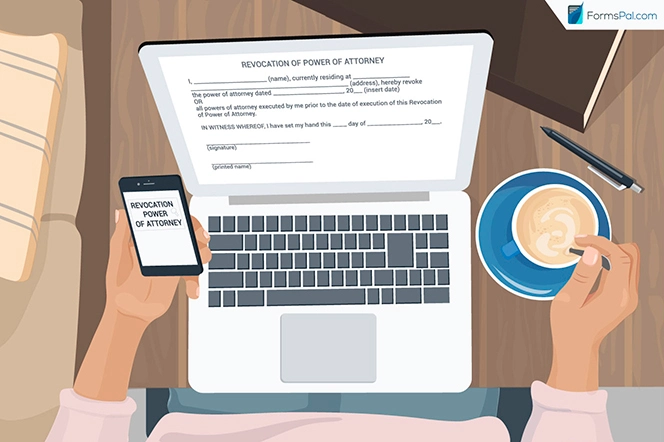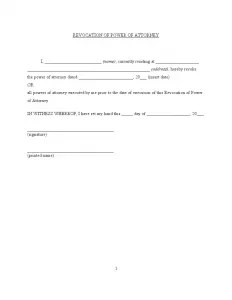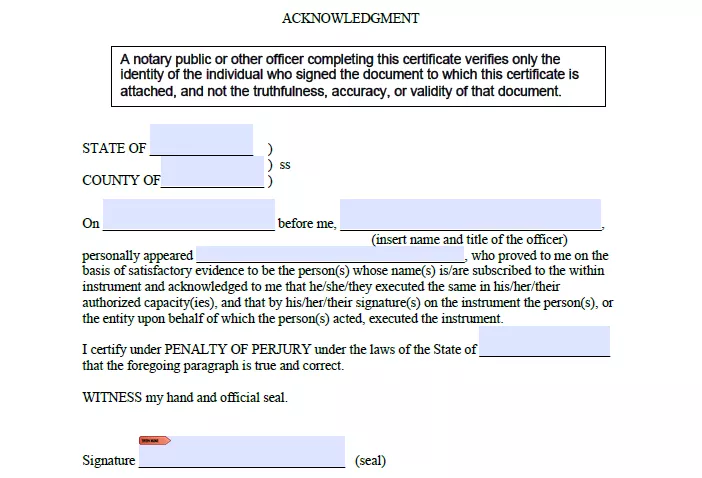Free Revocation of Power of Attorney Forms
Power of attorney forms can be incredibly powerful and can make managing your properties and finances much easier. The problem is that not every POA form can last forever, and at some point, you’ll probably want to cancel a power of attorney that looked like a good idea at first.
There are plenty of reasons to revoke a power of attorney, and we’ll go into some of them in just a moment.
Like any legal process, there are specific steps that you have to follow to terminate the power of attorney. Knowing how to complete the revocation of power of attorney form is critical because until the entire process is finished, your old power of attorney is likely still considered valid.

Build Your Document
Answer a few simple questions to make your document in minutes
Save and Print
Save progress and finish on any device, download and print anytime
Sign and Use
Your valid, lawyer-approved document is ready
When and Why to Revoke a POA
Power of attorney documents can be incredibly powerful, and there are plenty of reasons that you might want to revoke a power of attorney document.
Some power of attorney documents also end naturally, called a limited POA. These estate planning documents are designed to only last for a specific period of time or the length of a specific transaction instead of lasting indefinitely.
Unless there is a specific reason you want a durable power of attorney or indefinite POA, you may want to consider limiting your original document so that you don’t have to worry about revoking a power of attorney later.
Reasons to Revoke a POA
If you haven’t set up a limited power of attorney, there are many reasons you may want to consider revocation.
One of the most common reasons to revoke power of attorney is simply that the reasons you created the POA in the first place are no longer valid. For instance, if you created a power of attorney so that your attorney-in-fact could manage your properties in a different state, and then you moved closer to those properties, you likely no longer need a power of attorney.
Another common circumstance is not that you don’t need a power of attorney any longer, but rather that you need a new POA instead of the old one. In that case, you’d use an attorney revocation form to revoke the power in your original POA and create a new one.
But you may also need to consider a revocation if your circumstances have changed, like in the case of a divorce or a change of economic fortunes. In some states, a power of attorney revocation might be automatic if you divorce your spouse and they were your attorney-in-fact. However, that isn’t true everywhere, so you should always check to see whether you might need an attorney revocation form included in your divorce.
Changes in circumstance can include:
- Divorce
- New Marriage
- Moving to a different state or country
- Large change in economic status
- Change of profession (so that you no longer need a POA or need a different POA)
You may also need to move forward with the revocation if your attorney-in-fact has proven to be unreliable. It may be as simple as the person you originally appointed not having the skills or time needed, or you may have discovered that your attorney-in-fact was acting in bad faith, and you want to appoint someone else.
Your Agent Asks to Relinquish Power
In some circumstances, you may also need an attorney revocation because your agent has asked to relinquish power of attorney.
Your agent cannot revoke their own power of attorney. They can refuse to act, in which case the responsibility and authority of the original power of attorney fall to your other agents or the next attorney in fact in line. But even if your agent has refused to act that is not an official revocation of power outside of that specific circumstance.
If your attorney-in-fact asks for revocation, it’s best to fill out a revocation of a POA form and then create a new power of attorney to replace them.
Of course, this is just a small list of the possible reasons why you might need a revocation of power form. You may need to make extensive changes to the original legal document, for instance, or you may want to make changes based on legal advice you’ve received since creating the original power.
When You Can Revoke POA
You may wonder if there are any circumstances where you cannot get a revocation of power form as the principal named on a power of attorney. There are a very few indefinite power of attorney forms that may have been filled out, but usually, you won’t have gotten one of those power of attorney without legal advice or court order.
Short of that, the principal can pursue revocation of power at any time so long as they are still mentally competent. Most POA forms will also expire naturally if you are no longer of sound mind or are otherwise incapacitated.
The only power of attorney that does not expire if you are incapacitated is called a durable power of attorney. It’s doubly important to make sure you pick the right agent for a durable power of attorney because they will retain the power even after you have been incapacitated. You may not be able to get a revocation depending on the circumstances.
Revocation of Power of Attorney Document Details
| Document Name | Revocation of Power of Attorney Form |
| Other Names | Termination of Power of Attorney, Cancellation of Power of Attorney |
| Explanation for Revocation | Not required |
| Filing of Revocation PoA | Required only if a power of attorney was recorded with the County Recorder’s Office or Land Titles Office |
| Avg. Time to Fill Out | 5 minutes |
| # of Fillable Fields | 17 |
| Available Formats | Adobe PDF; MS Word |
Steps to Revoking a POA
Many people wonder how to revoke a power of attorney once given, and it can even be a reason why they don’t create a power of attorney in the first place. Fortunately, it’s relatively simple to get a revocation of power of attorney form, and revocation is usually easier than creating a power of attorney in the first place.
This whole system is relatively straightforward, but it’s important to remember that the revocation isn’t official until the legal documents have been filled out and the entire process is finished. Your attorney-in-fact can continue acting with power of attorney until you’ve completed the form, not until you’ve started it.
If you need an urgent attorney revocation, try to complete the form and send it to all relevant parties on the same day.
Don’t worry, a one-day turnaround on revocation forms is very doable. The main thing you need to do is make sure you can see a notary public the same day.
Step 1: Find a Free Revocation Form

The first step is to find a revocation form you can fill out. While you can write a revocation form yourself, using a free legal document makes the whole process much faster and easier.
Most of these forms are fairly simple, like our revocation of power of attorney form. If the form is too complex look for an alternative.
Step 2: Fill Out the Form

Filling out these forms should be pretty straightforward. Don’t worry, we’ll walk you through the process in the next section. The most important step is making sure the form is signed and notarized. Getting the revocation notarized is especially important if the original power of attorney document was also notarized.
Step 3: Send the Finished Document to All Parties Involved

The last step is to send out the finished document to everyone relevant. That includes your agent, successor agents, bank, and other institutions that had a copy of the original legal papers.
You can send the document by mail, email, or fax. However, it’s recommended that you use registered mail since you get a delivery confirmation. That way your attorney-in-fact cannot continue acting as your agent and claim that they never received word of your revocation.
It’s important to get the document in writing. While you can verbally revoke a power of attorney, proving that you have done so is challenging. It may not be legally binding if the original power of attorney was in writing.
If you have a good relationship with your agent, you may want to consider telling them about the revocation in person. That way, you can offer an explanation of why you want to move forward with revoking a power of attorney. Telling them in person may be especially important if your agent is a close friend or family member.

How to Fill Out a Power of Attorney Revocation Form
Step 1: Fill Out Personal Information
Like most legal documents, the first step after finding the template is to fill out your personal information. For the revocation of power of attorney, you need to include your full legal name and your current address.

Step 2: Fill Out the Date of the Original Power of Attorney Document
You will also need the original date of a power of attorney. The date is used to identify a POA you’re talking about, though you may need to get more specific if you’ve filled out multiple power of attorney simultaneously.
You can also revoke all the POA you’ve filled out prior to this revocation of power which is useful if you aren’t sure when you finished the original POA or only have one or two POA on file.

Step 3: Have Your Revocation Witnessed and Notarized
All revocation of POA forms will need to be witnessed by a third party, and you will also need the witness to sign and date the form.
It’s easiest to get your revocation witnessed and notarized simultaneously. If your revocation is completed at the bank, you may get the bank to provide a witness and your notary public.

Step 4: Send Copies of Your Revocation to All Involved Parties
The last step is to send out copies of your revocation. You’ll need to send copies to your previous POA agent and any businesses or banks they may have worked with on your behalf. You should also send copies to your local county clerk and your lawyer if you have one.
You can deliver the documents in person, via email or fax, or through the postal service. We recommend using registered mail so that you have legal confirmation that the form was received.
